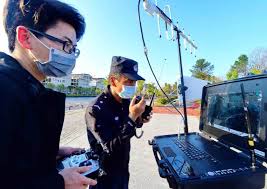Source: asiaone.com
On Feb 3, medical workers at Wuhan Pulmonary Hospital in the central province of Hubei welcomed a new “comrade”, one who had no fear of the novel coronavirus even though he wasn’t wearing protective clothing - a robot designed to deliver medication and meals.
“Please wear masks and wash your hands frequently during this special period. Let’s conquer the difficulties together,” the robot intoned as it moved around the Department of Respiratory Medicine.
Li Ming, deputy director of the hospital’s information department, said the robot’s route is based on a map set by a computer programme.
Nurses bring meals for the 60 patients to the quarantine area and place them on the robot, which can deliver 10 to 15 in one journey, saving time and energy while also reducing human contact.
In a bid to save protective gear and prevent infections among medical workers, the hospital has launched an online system that allows doctors to check patients via video screens.
Meanwhile, an online diagnosis system has been built to support treatment in hospitals in Enshi and Xiangyang, both in Hubei, and the expert team at Wuhan Pulmonary Hospital has provided diagnoses for more than 30 patients via remote consultations.
UPGRADES
Faced with the epidemic, governments at all levels, tech companies and local communities are joining the battle against the coronavirus by upgrading the technological aspects of control and prevention work.
Last month, President Xi Jinping said the battle against the epidemic cannot be won without scientific and technological support, according to Xinhua News Agency.
On Feb 28, the Ministry of Science and Technology published a notice on its website encouraging businesses to deploy robots, temperature-screening machines and other devices that could help to reduce human contact as the nation returns to work following the enforced layoff after the Spring Festival Holiday.
Big data is being collected on platforms to monitor the development of the epidemic, while drones are being used to disinfect roads and open spaces. Meanwhile, temperature-screening technology and artificial intelligence are being employed in the detection and analysis of possible risks amid the gradual resumption of work.
Residents nationwide can trace the latest developments of the epidemic and obtain health tips from online sources, such as WeChat mini programs launched by internet companies like Tencent Holdings.
An epidemic map, locations of communities with confirmed cases and information to refute rumours are available on the monitoring platforms, which aim to provide people with accurate information in a timely manner.
Cities in Hubei, such as Xiangyang, Suizhou and Xiaogan, have built online platforms where people can report developments related to the epidemic, search their travel history to see if they shared planes or rail carriages with people who were later confirmed as having the coronavirus, and receive a remote diagnosis.
Led by the local governments of several cities in Hubei and the e-commerce giant Alibaba, these kinds of platforms facilitate control-and-prevention work in communities by ensuring that people returning from Wuhan are registered and placed under observation.
SOFTWARE SOLUTIONS
Alipay Health Code - smartphone software that indicates health status - was rolled out in more than 100 cities nationwide within a week of being introduced in Hangzhou, Zhejiang province, on Feb 11, according to Xinhua News Agency.
After people fill in a survey of their recent travel history, close contacts, temperature and related symptoms, they are assigned a code in green, yellow or red, depending on their suggested physical condition.
Those with green codes can freely enter or exit communities and workplaces, while those with red or yellow codes should enter a period of self-quarantine.
As of Feb 28, more than 15 million people in Zhejiang had registered with the system, which provides a visual indication of whether it is safe for them to return to work. “Have you turned green?” has become a popular catchphrase in the province.
NONHUMAN DELIVERIES
In addition to robots in hospitals, the e-commerce giant JD is deploying self-driving robots to deliver items to medical workers in Wuhan in a bid to protect both customers and employees.
The robots can easily cover the distance between the logistics point and a designated hospital, about 600 meters, according to the Shanghai Observer news portal.
Meanwhile, in some parts of the country, drones are being used to patrol open places, spray disinfectant and conduct thermal-imaging procedures.
Liu Shuai, a farmer in Mianzhu, Sichuan province, allowed the local village authorities to use a newly purchased agricultural drone to spray disinfectant.
“Drones are more convenient, and they can spray material more evenly than manual or electric devices,” he told Red Star News.
He volunteered to operate the drone and spray roads in his village at 9 am every morning. The work used to take a team a whole day to finish, but Liu completes the task in about three hours.
Meanwhile, a community official in Yichun, Jiangxi province, started a trend of using drones equipped with thermal-imaging technology to assess body temperatures, according to news portal Jiemian.
Yi Jinyu, who enjoys working with new technologies such as drones, 3D printing and data visualisation, bought the device from DJI, a leading provider of easy-to-fly drones.
During its 30 minutes of flight time per charge, the drone can detect temperatures ranging from -10 deg C to 140 deg C, thereby meeting all the demands for widespread inspections of people and goods in open spaces.
In January, Yi came up with the idea of deploying drones to assess temperatures.
After he started using the drone to gauge temperatures, many other communities quickly decided to follow suit.
On Feb 2, a community in Hangzhou started using the devices to conduct temperature checks in open spaces, such as parks.
If an individual registers a temperature reading that may indicate a fever, he or she is located by officials who conduct tests to ascertain the details of the situation and respond accordingly.
